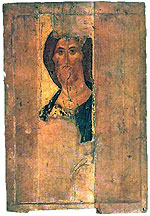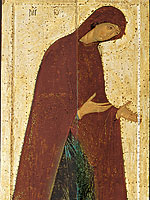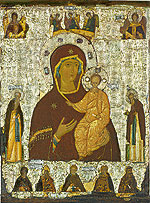 | ||
Dionisy’s Autographin the soffit of the northern portal. It describes the creation of the St. Ferapont Monastery frescoes (left side) Search | ||
 |
|
Dionisy (Dionisius). c.1450–c.1520
Dionisy was entered in the paterikon of the St. Joseph Volokolamsk Monastery as Dionisy the Wise.
Dionisy, an outstanding icon painter and the most venerated artist at the turn of the 15th and 16th centuries in Russia, was a contemporary of Raphael, Leonardo, Botticelli and Durer.
 Christ the Redeemer. Zvenigorod Tier. Andrei Rublev |
Succeeding and developing Andrei Rublev’s legacy, Dionisy created works that reflected a revival of Russian culture during an era when the Russian state was being unified. By the end of the 15th and beginning of the 16th centuries, the annexation of Novgorod, Pskov and Tver to Moscow ended the process of gathering Russian lands into a centralized state. In autumn 1480, the Great Standing on the Ugra River marked the final fall of the Tatars’ Golden Horde yoke.
In the late 15th century, under Ivan III, the new position of Moscow as the capital of a vast unified European state made it necessary to reconstruct the Moscow Kremlin and as a result the Dormition Cathedral (1475-1479) and the Annunciation Cathedral (1484-1489) were rebuilt and the Church of the Deposition of the Robe (1484-1486) was constructed.
Dionisy, who is the second most important painter of Old Rus (after Andrei Rublev), is associated with this period. He painted in an atmosphere of spiritual rebirth, massive construction in Moscow and an intense apocalyptical mood connected with waiting for Doomsday at the end of the seven thousand years (according to the Old Russian chronology).
 Theotokos. Dionisy and his studio. 1490s or 1502-1503 |
Various historic sources that mention Dionisy admire his wisdom and talent. Apparently, it was to him that the prominent ideologist, writer and public figure of those times Joseph Volotsky addressed his writings. Dionisy’s themes are determined by religious and philosophical ideas of public service and duty and an original interpretation of the role of Russia in the course of history. Confident and elegant drawing, light transparent colours, unique compositional harmony and flowing lines are inherent to Dionisy’s art. Images created by Dionisy are imbued with spiritual serenity and represent the forthcoming Kingdom of God.
The dates of his life are not exact: he was born in about 1450 and died around 1520. He had three sons: Theodosius and Vladimir, who were icon painters, and Andrew.
Dionisy became famous for his frescoes in the St. Paphnutius Borovsk Monastery.
The most celebrated icons were painted in Moscow: Metropolitan Peter with scenes from his life and Metropolitan Alexius with scenes from his life (1481) for the Kremlin Cathedral of the Dormition and the Virgin Hodegetria icon (1482) for the Ascension Monastery.
 Mother of God Hodegetria of Smolensk with the Saints. Dionisy. The last quarter of the 15th century |
Icons made by Dionisy for the Volga monasteries: St. Paul Obnorsk , Saviour Priluki and St. Cyril Belozero survived intact. It is also known that Dionisy painted the iconostasis of the Kamenny Monastery, situated near Vologda. Russian chronicles mention Dionisy’s frescoes adorning cathedrals of the St. Joseph Volokolamsk Monastery outside Moscow and the Chigasov Monastery in Moscow.
The art of the eminent icon painter reached its peak at the beginning of the sixteenth century during his work in the Northern Volga monasteries in Belosero and Vologda regions. Then, in 1502, Dionisy together with his sons created a unique group of frescoes and icons for the Virgin Nativity Cathedral of the St. Ferapont Monastery, the only surviving mural by Dionisy where the artist’s artwork has been preserved practically intact.
Experts know of around ten cathedrals whose walls were painted by Dionisy. Some of the painter’s works are lost for good; some have been preserved by restorers
Only the wall painting of the Virgin Nativity Cathedral of the St. Ferapont Belozero Monastery has survived in full and intact |
|
According to historical documents, the following works of Dionisy (the dates indicate the year of their painting) are known:
 John the Baptist. Dionisy and his studio. 1490s or 1502-1503 |
See also: |
|
|
 |
SUPPORTING WITH:
| |||||||||||||








